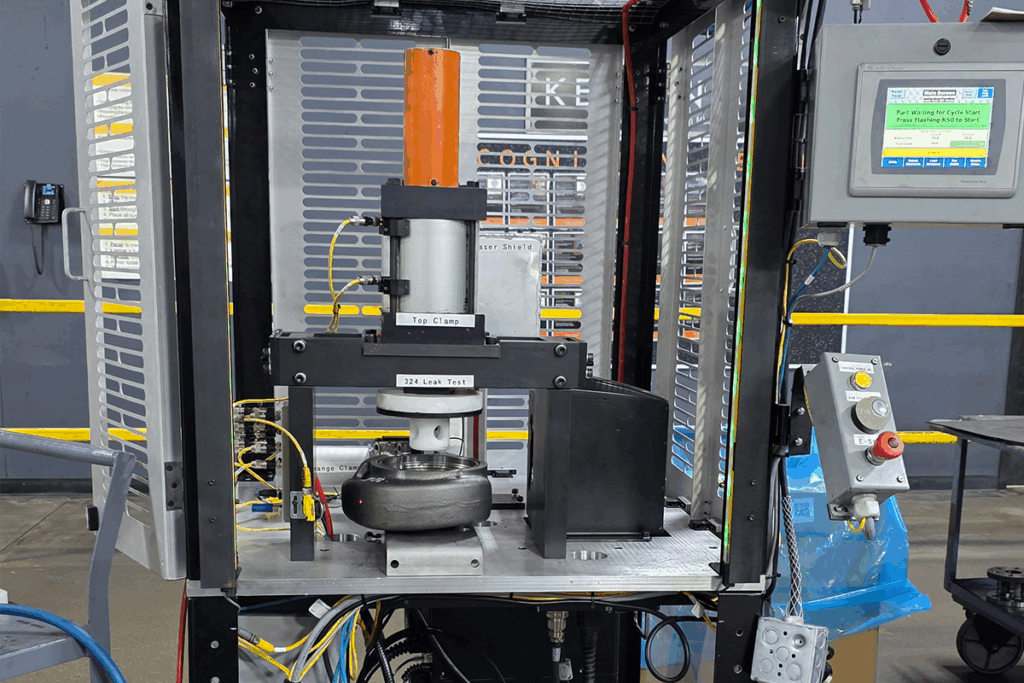Creating high-quality precision machined parts and components for automotive applications requires attention to detail from the design phase to final delivery, including throughout the quality control processes.
Leak testing is critical to quality control on parts designed to hold a pressurized fluid or gas. These techniques test the part’s ability to withstand pressure under normal usage conditions because a leak, even if microscopic, can result in application failures, safety hazards, and operational inefficiencies.
What Are The Three Types Of Leak Testing In Precision Machining?
Generally, automotive components suppliers have three main options for leak testing on their precision machined parts and components.
Air Pressure Decay Testing
One of the most common leak detection methods used in precision machining is air pressure decay testing, a nondestructive testing (NDT) method that measures the loss of pressure within a sealed component.
The process works by filling a pressure vessel with compressed air to a predetermined pressure level before cutting off the air source. A pressure transducer then detects and records changes in pressure, which are analyzed to determine if they fall within acceptable limits. A leak is indicated if the pressure decay is greater than a predetermined setting over a set period of time.
Most air pressure decay tests can be done relatively quickly with highly accurate results. However, larger parts require longer cycles to get the most accurate results possible. In both cases, the testing process is so simple that it can easily be automated and integrated into the manufacturing and assembly processes.
This cost-effective method delivers accurate results for general leak detection in automotive fuel systems, radiators, and other components.
Vessel Leak Testing
This leak testing method is perfect for detecting leaks in high-pressure applications such as sealed containers, pressure vessels, piping systems such as fuel and hydraulic systems, or anywhere structural integrity under pressure is critical to the part’s performance.
There are many different types of vessel leak testing, but these two standard techniques are generally used most often:
Hydrostatic Testing
This technique involves completely filling the component with water or another incompressible fluid, removing the air within the unit, and pressurizing the system up to 1.5 times its maximum allowable working pressure (MAWP) limit. Although 3.5 times the MAWP is still the standard safety factor, 1.5 times the MAWP is used to prevent damage to the vessel. Leaks are determined by visual inspection or pressure loss measurements.
Pneumatic Testing
Pneumatic testing uses the same principle as hydrostatic testing but uses a gas such as oxygen or nitrogen instead of water. Leaks are detected through pressure decay measurements, especially around the part’s welds and seams.
Helium Leak Testing
Helium leak testing offers unmatched sensitivity for detecting extremely minuscule leaks, even as small as 10⁻¹² atm-cc/sec, in automotive fuel, hydraulic, and air conditioning systems, as well as fuel tanks and radiators. Its ability to perform so efficiently at such a level is due to helium’s small atomic size and low viscosity, which makes it perfect for penetrating tiny leak paths.
One of three helium leak testing methods are typically used in manufacturing:
Vacuum Method
With this technique, helium is released inside a part placed in a vacuum chamber. A mass spectrometer detects if helium has escaped into the chamber, indicating a leak.
Sniffer Method
The sniffer method involves pressurizing the part with helium. An operator then uses a sniffer probe to detect if helium is escaping from the part, especially at likely leak points, such as welds or flanges.
Accumulation Method
The accumulation method process starts with pressurizing the test component with helium and sealing it in a chamber. The chamber is then monitored for an increase in helium concentration over time.
Read More: Our Capabilities
Which Leak Test Method Is Best For Your Precision Machine Components?
With so many options available, it can be challenging for manufacturers to decide which leak test technique is next for their application. Factors to consider during the planning process include component material, sensitivity requirements, regulatory standards, final application, and budget.
When you partner with the engineering team at Kenona Industries, a division of Arrow Automotive, you’re never making these decisions alone. We support you through the entire process and will present recommendations that will ensure high-quality results that are compliant with industry standards and will perform safely and efficiently in your applications.
Since 1988, our engineers, controls engineers, software engineers, and robotics experts have used advanced technology to deliver the highest-quality parts and components for gas-powered and electric vehicle components, no matter how large or complex, even with the tightest tolerances.
Our skills, experience, and knowledge in complex, cost-effective metal design and fabrication solutions will always bring you the best results. Contact our team first when you’re ready to build!
Contact Kenona Industries for a quote on your next design and fabrication project. Kenona Industries is a world-class automotive components supplier to leading automotive OEM and Tier 1, 2, and 3 manufacturers. Discover everything that sets us apart by requesting a quote for your next project today!
